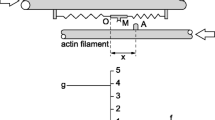Abstract
Skeletal muscle is a highly regulated, voluntarily controlled tissue. Coordinated muscle action via neurological and metabolic input is realized in various muscle fiber types. In general, these types include I, IIa, and IIx. The primary metabolic qualities of each type are slow, medium fast, and fast contraction speeds, respectively. Knowledge of fiber-type energy systems is paramount and initially discussed in relation to aerobic and anaerobic qualities of muscle action. Next, muscle force production via the sliding filament theory (SFT) is examined and underscored as the primary, basic pattern invoked to produce human locomotion or movement as muscle tendinous attachments pull on bone. Therefore, an understanding of the above fiber types and their ability to produce varying degrees of force may lead to better quality care during rehabilitation from injury. Finally, a brief discussion about various proprioceptors in muscles, joints, and tendons punctuates the chapter.
Access this chapter
Tax calculation will be finalised at checkout
Purchases are for personal use only
Similar content being viewed by others
References
Bergstrom J, Hermansen L, Hultman E, et al. Diet, muscle glycogen and physical performance. Acta Physiol Scand. 1967;71:140–50.
Foskett A, Williams C, Boobis L, et al. Carbohydrate availability and muscle energy metabolism during intermittent running. Med Sci Sports Exerc. 2008;40:96–103.
Green HJ, Ball-Burnett M, Jones S, et al. Mechanical and metabolic responses with exercise and dietary carbohydrate manipulation. Med Sci Sports Exerc. 2007;39:139–48.
Murakami I, Sakuragi T, Uemura H, et al. Significant effect of a pre-exercise high-fat meal after a 3-day high-carbohydrate diet on endurance performance. Nutrients. 2012;4:625–37.
McArdle WD, Katch FI, Katch VL. Exercise physiology: nutrition, energy, and human performance. 7th ed. Philadelphia: Wolters Kluwer; 2010.
Enoka RM. Morphological features and activation patterns of motor units. J Clin Neurophysiol. 1995;12:538–59.
Huxley H, Hanson J. Changes in the cross-striations of muscle during contraction and stretch and their structural interpretation. Nature. 1954;173:973–6.
Huxley A, Niedergerke R. Structural changes in muscle during contraction: interference microscopy of living muscle fibres. Nature. 1954;173:971–3.
Huxley A. Muscle structure and theories of contraction. Prog Biophys Biophys Chem. 1957;7:255–318.
Brooks GA, Fahey TD, Baldwin KM. Exercise physiology: human bioenergetics and its applications. 4th ed. Boston: McGraw-Hill; 2005.
Rassier D, MacIntosh BR, Herzog W. Length dependence of active force production in skeletal muscle. J Appl Physiol. 1999;86:1445–57.
Farrell PA, Joyner MJ, Caiozzo VJ, et al. ACSM’s advanced exercise physiology. 2nd ed. Philadelphia: Wolters Kluwer Health; 2012.
Komi PV, IOC Medical Commission, International Federation of Sports Medicine. Strength and power in sport. 2nd ed. Osney Mead: Blackwell; 2003.
Stone M, O’bryant H. Weight training: a scientific approach. 2nd ed. Minneapolis: Burgess; 1987.
Sandow A. Excitation-contraction coupling in muscular response. Yale J Biol Med. 1952;25:176–201.
Ribeiro F, Oliveira, J. Aging effects on joint proprioception: the role of physical activity in proprioception preservation. Eur Rev Aging Phys Act. 2007;4:71–6.
Baechle TR, Earle RW, National Strength & Conditioning Association (U.S.). Essentials of strength training and conditioning. 3rd ed. Champaign: Human Kinetics; 2008.
Bunton EE, Pitney, William A, Cappaert, Thomas A, Kane, Alexander W. The role of limb torque, muscle action and proprioception during closed kinetic chain rehabilitation of the lower extremity. J Athl Train. 1993;28:10–11, 14, 16, 19–[20].
Acknowledgment
The authors warmly thank Elizabeth A. Drum for her time, efforts, and expertly drawn figures.
Author information
Authors and Affiliations
Corresponding author
Editor information
Editors and Affiliations
Rights and permissions
Copyright information
© 2016 Springer Science+Business Media New York
About this chapter
Cite this chapter
Drum, S., Weatherwax, R., Dixon, J. (2016). Physiology of Skeletal Muscle. In: Dixon, J. (eds) Muscular Injuries in the Posterior Leg. Springer, Boston, MA. https://doi.org/10.1007/978-1-4899-7651-2_2
Download citation
DOI: https://doi.org/10.1007/978-1-4899-7651-2_2
Published:
Publisher Name: Springer, Boston, MA
Print ISBN: 978-1-4899-7649-9
Online ISBN: 978-1-4899-7651-2
eBook Packages: MedicineMedicine (R0)




